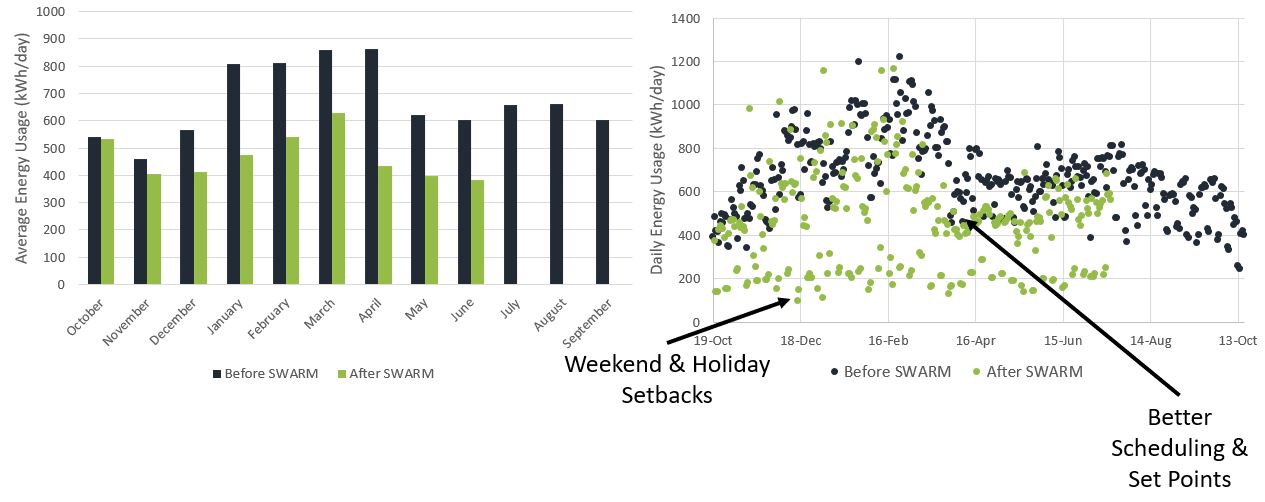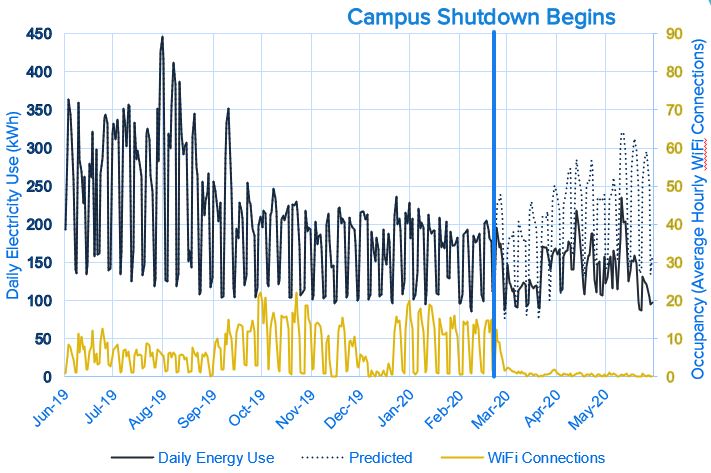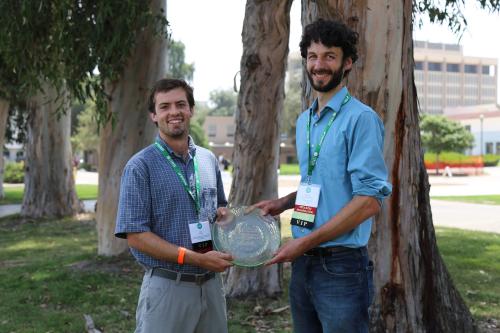Small Workplace Automation and Remote Monitoring
The UC Davis main campus houses around 1,200 buildings of various sizes and usage. Some larger buildings' HVAC (Heating, Ventilation, and Air Conditioning) systems can be monitored remotely from Facilities Management because they are connected centrally to the same system. However, this leaves out smaller buildings that operate from individual HVAC units, like the ones you would have in your home.
The smaller buildings make up about 15% of overall campus square footage, which can be difficult to monitor due to lack of visibility on our remote systems.
UC Davis's Energy & Engineering team uses Pelican Wireless internet enabled thermostats, economizer controllers, and site management to schedule and monitor small buildings across campus. The results have moved SWARM from a three-building pilot project to a campus standard for small buildings.
SWARM now controls 72 buildings and 340,000 square feet of campus, including 1,000+ tons of heating and cooling! UC Davis will see energy savings of 700 MWh/year of electricity, 6,000 therms/year of natural gas, and $68,000/year in cost savings thanks to SWARM.
Case Study of Energy Savings
After implementing SWARM in the IET Communication Resources and the Materials Management Office buildings, we saw a 43% reduction in energy just from scheduling improvements.

Case Study of Holiday Shutdowns and Extended Vacancy
After building relationships with occupants, the Energy & Engineering Team is able to communicate with the occupants for upcoming holidays and periods of extended campus shutdown events such as the COVID-19 suspended operations period to shutdown HVAC systems for entire buildings or certain zones. SWARM has enabled 31 buildings totaling 49% of the SWARM footprint to be scheduled off for part or all of the COVID-19 suspended operations; these buildings would have been running on their normal schedule if not for the remote scheduling capability implemented by SWARM.
As an example, the Barn has seen a total energy reduction compared to the predicted use of 32% since mid-March just from scheduling the HVAC in the building off! The graph below shows how energy use stayed lower than predicted as people left the building for the COVID shutdown.

SWARM is Award Winning!
In 2018, SWARM won an award in Energy Efficiency at the Campus Level
at the California Higher Education Sustainability Conference.

In the SWARM project, UC Davis deployed simple and flexible internet-connected thermostats and electricity meters to small buildings. The new networks united the small buildings into a centralized system for HVAC scheduling, energy monitoring, and remote troubleshooting. In addition to being scalable in breadth, HVAC control and energy monitoring are the infrastructure backbones that allow for other innovative projects. For example, in the first few months after coming online at UC Davis, another energy group leveraged the small building scheduling to test thermal leakage from outside the building. A third group started an HVAC and lighting integration project that would not have otherwise been possible.
Participating SWARM Buildings
SWARM is a tool you can use on your own campus.
With the generous funding from the UC Office of the President's Carbon Neutrality Initiative, the Energy & Engineering team has developed a toolkit for other UC campuses, designed to help kickstart pilot SWARM projects. For more information and collaboration send us an email.
The resources below are guides for identifying potential SWARM buildings, approaching HVAC technicians, campus IT, and building occupants to explain the benefits and logistics of SWARM, and tracking the energy use and savings from implementing SWARM.
Energy Managers
The resources for an energy manager are meant to help start pilot projects and take these pilots to campus-wide practices.
Energy Manager Module.pptx
Energy Data Analysis Module.pdf
Technical Reference Guide.pdf
HVAC Technicians
The stakeholders who will have the most day-to-day interaction with SWARM will be the HVAC technicians that respond to hot and cold calls and take work orders for HVAC equipment. It is crucial for them to understand and be comfortable using the technology, so along with this information module, the Energy & Engineering team is happy to offer information and training sessions for the program.
HVAC Technician Module.pdf
Campus IT Team
Because SWARM requires hooking into the campus internet infrastructure, collaboration with the IT team is required. The more confident the IT team is with the technology involved in SWARM, the quicker projects will be able to be installed.
IT Module.pdf
Building Occupants
If building occupants are interested in how SWARM works and how it will affect them, they can refer to this module.
Building Manager Module.pdf